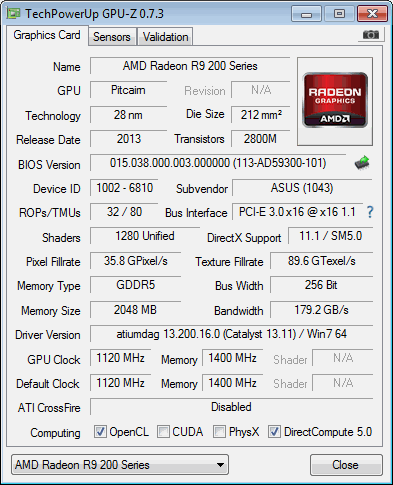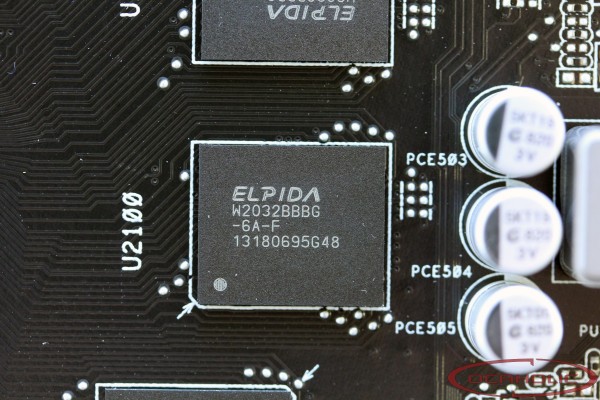ASUS Radeon R9 270X DirectCU II Top Review
Published by Christian Ney on 10.10.13Page:
Technical Data / Specifications
ASUS ships its Radeon R9 270X DirectCU II Top card with the core clocked at 1'120 MHz and the memory at 1'400 MHz (5'600 effective). Compared to the R9 270X reference clocks the Top has a shy factory overclocking, 70 MHz on the core and nothing on the memory.Although the R9 270X has the PowerTune Boost functionality we never saw it in action. We mean that, though the manufacturer advertises it otherwise, the DirectCU II Top has technically a core clock of 1'050 MHz and a boost clock of 1'120 MHz. During our testing, the card was always running at full speed of 1'120 MHz under load, we didn't experience any clockdown.
AMD themselves are being obscure on that point too, the reference R9 270X has actually a base clock set at 1'000 MHz with a boost clock of 1'050 MHz but AMD just write down "GPU Clock Speed: Up to 1'050 MHz". The latter is not wrong but it's not exact either.

| ASUS DirectCU II Top | Radeon R9 270X | Radeon HD 7870 | |
| Chip | Pitcairn XTL Curacao XT |
Pitcairn XTL Curacao XT |
Pitcairn XT |
| Process | 28 nm | 28 nm | 28 nm |
| Transistors | 2.80 billion | 2.80 billion | 2.80 billion |
| GPU clock | 1'120 MHz | 1'050 MHz | 1'000 MHz |
| Memory GDDR5 | 2'048 MB | 2'048 MB | 2'048 MB |
| Memory clock | 1'400 (5'600) MHz | 1'400 (5'600) MHz | 1'200 (4'800) MHz |
| Memory interface | 256 Bit | 256 Bit | 256 Bit |
| Memory bandwidth | 179.2 GB/s | 179.2 GB/s | 153.6 GB/s |
| Shader Cores | 1'280 | 1'280 | 1'280 |
| TMUs | 80 | 80 | 80 |
| ROPs | 32 | 32 | 32 |
| TDP | xxx Watt | 180 Watt | 190 Watt |
| PCB Type | Custom Design | Reference Design | Reference Design |
| Lenght (PCB - Total) | 24.3 - 27.3 cm | xx.x - xx.x cm | xx.x - xx.x cm |
| Height (PCB - Total) | 11.2 - 13.2 cm | xx.x - xx.x cm | xx.x - xx.x cm |
| Slots | 2 | 2 | 2 |
| Cooler | DirectCU II | AMD Reference | AMD Reference |
| Launch Price | $XXX | $199 | $350 |
To cool its Radeon R9 270X ASUS makes use of the same DirectCU II cooler you find on the Radeon HD 7870 DirectCU II Top V2. When you put the two cards one next to each other you see only one difference, which lies in the shape of the plastic cover. Otherwise the cooler is exactly the same. In this case you get three eight millimeter heatpipes. The heatpipes have been nickel plated but on the bottom part in contact with the core. Soldered to the heatpipes you find the fin stack which is being provided with fresh air via two 75mm fans. Both fans are identical and being manufactured by Everflow. They carry the model number T128010SH.
Overall the cooler is well made and finished. The thermal paste used is of pre-applied type unlike on the R9 280X where a better quality soft paste has been spread. Most memory chips aren't activelly cooled, there are only two and a half chips that are being actively cooled, the ones located right above the socket. They are in contact with the cooling unit thanks to a thermal pad.
Like most of ASUS' DirectCU II series the PCB has been completely reworked and the power design beefed-up. The PCB and the power design are almost identical to what powers the Radeon HD 7870 DirectCU II Top V2, there are only some minor changes. A closer look at it shows a seven phases power implementation for the main power design where the GPU gets six (there are five on the reference card) and the memory one. Going further we see, two additional phases for the IO and the pll.
No heatsink has been mounted on the MOSFETs, they are being passively cooled by the airflow. The manufacturer decided to equip its 270X with only the metal reinforcement located at the top end of the card to prevent bending rather than the full backplate + reinforcement solution. A cost efficient solution that doesn't protect the card unfortunately.
Components wise ASUS makes use of high quality so called Super Alloy Power components.
Checking the voltage regulation chip we find a digital multi-phase controller labelled Digi+ ASP1211 for the GPU, probably a rebranded CHiL 8228 or 8318.
There are three single phase APW7165A controllers from Anpec on this card. The upper one takes care of the memory, the middle one takes care of the IO and the last one takes care of the pll.
The memory chips used are made by Elpida and carry the model number W2032BBBG-6A-F. They are specified to run at 1'500 MHz (6'000 MHz effective).
| Navigate through the articles | |
 ASUS Radeon R9 280X DirectCU II Top Review
ASUS Radeon R9 280X DirectCU II Top Review |
MSI Radeon R9 270X HAWK Review
 |
|
|










